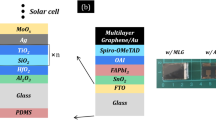Abstract
The interest in indium-free transparent composite electrode (TCE), a thin metal layer embedded between two transparent metal oxide (TMO) layers resulting in TMO/metal/TMO composite structure, has grown recently with the advent of their high figures of merit and its potential application in photovoltaic applications. However, most of the work to date has focused on experimentally producing the best optically transmitting TCE. To better design TCEs and minimize experimental work, it would be useful to develop a model that predicts the optical transmission. In the current work, the transfer-matrix method is employed to calculate the transmittance spectrum of TCE. To validate this approach, the transmittance spectra of TiO2/Au/TiO2 and TiO2/Ag/TiO2 multilayer thin-film TCEs are calculated with use of extracted material parameters. The calculated transmittance spectrum of TiO2/Au/TiO2 matches the measured spectrum quite well. However, the calcualted transmittance of TiO2/Ag/TiO2 is higher than its measured transmittance. The presence of voids in the Ag film is probably responsible for the decreased transmittance of the TiO2/Ag/TiO2 sample, and the continuous Au film in TiO2/Au/TiO2 ensures a good agreement between transmittance prediction and measurement. Our approach is a reliable tool to predict the optical transmittance of TCE with continuous films, and it can efficiently expedite the selection from numerous possible combinations of transparent metal oxides and metals when developing TCEs for future photovoltaic applications. It can also serve as a convenient method to assess the continuity of embedded metal layer.



Similar content being viewed by others
References
K. Sivaramakrishnan and T.L. Alford, Appl. Phys. Lett. 96, 2011109 (2010).
A. Dhar and T.L. Alford, APL Mater. 1, 012102 (2013).
A. Dhar and T.L. Alford, J. Appl. Phys. 112, 103113 (2012).
A. Kumar, R. Srivastave, M.N. Kamalasanan, and D.S. Mehta, Opt. Lett. 37, 575 (2013).
J.H. Lee, K.Y. Woo, K.H. Kim, H.D. Kim, and T.G. Kim, Opt. Lett. 38, 5055 (2013).
C. Guillén and J. Herrero, Thin Solid Films 520, 1 (2011).
L. Cattin, M. Morsli, F. Dahou, S.Y. Abe, A. Khelil, and J.C. Bernède, Thin Solid Films 518, 4560 (2010).
D.R. Sahu, S.-Y. Lin, and J.-L. Huang, Appl. Surf. Sci. 252, 7509 (2006).
C. Guillén and J. Herrero, Phys. Status Solidi A 206A, 1531 (2009).
A. Dhar and T.L. Alford, MRS Proc. 1577, mrss11-1322-b06-04 (2013).
J.A. Jeong, Y.S. Park, and H.K. Kim, J. Appl. Phys. 107, 023111 (2010).
A. Dhar and T.L. Alford, ECS Solid State Lett. 3, N33 (2014).
E. Hecht and A. Zajac, Optics (Reading, MA: Addison-Wesley, 1974), pp. 71–88, 301–306.
P. Lecaruyer, E. Maillart, M. Canva, and J. Rolland, Appl. Opt. 45, 8419 (2006).
W. Ewart, Applications of Interferometry (London: Methuen, 1950), pp. 76–78.
Z.B. Wang, M.G. Helander, X.F. Xu, D.P. Puzzo, J. Qiu, M.T. Greiner, and Z.H. Lu, J. Appl. Phys. 109, 053107 (2011).
C.C. Katsidis and D.I. Siapkas, Appl. Opt. 41, 3978 (2002).
E. Centurioni, Appl. Opt. 44, 7532 (2005).
A. Poruba, A. Fejfar, Z. Remes, J. Springer, M. Vanecek, J. Kocka, J. Meier, P. Torres, and A. Shah, J. Appl. Phys. 88, 148 (2000).
P. Beckmann and A. Spizzichino, The Scattering of Electromagnetic Waves from Rough Surfaces (New York: Pergamon Press, 1963), pp. 80–91.
M.N. Polyanskiy, “Refractive index database,” http://refractiveindex.info.
Y.C. Han, M.S. Lim, J.H. Park, and K.C. Choi, IEEE Electron Device Lett. 35, 238 (2014).
Acknowledgements
This work was partially supported by National Science Foundation (C. Ying, Grant No. DMR-0902277) to whom the authors are greatly indebted.
Author information
Authors and Affiliations
Corresponding author
Rights and permissions
About this article
Cite this article
Zhao, Z., Dhar, A. & Alford, T.L. A Method for Efficient Transmittance Spectrum Prediction of Transparent Composite Electrodes. JOM 67, 1612–1616 (2015). https://doi.org/10.1007/s11837-015-1342-7
Received:
Accepted:
Published:
Issue Date:
DOI: https://doi.org/10.1007/s11837-015-1342-7




